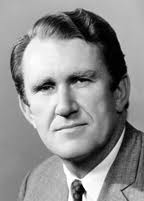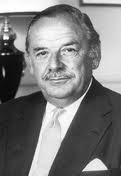In Australia, after the election of a ‘progressive’ Labor government in 1972, the Australian Chamber of Commerce (ACC - now the Australian Chamber of Commerce and Industry, ACCI) reacted with a nationwide ‘economic education campaign’ to promote free enterprise. Its 1972 Annual report stated:
The National Chamber sees, as its major objective, the need to promote and safeguard the interest of free enterprise, in its broadest, most constructive sense…. the exercise of normal business prudence will not in itself ensure the survival of the free enterprise system… The free enterprise story has to be told in a way that will obtain public recognition and understanding of the role of profits and individual initiative in the progress of this country.
ACC President in 1974, K. D. Williams, claimed that the ‘apparent increase of animosity towards business in Australia’ was ‘part of an international phenomenon’ and business was being ‘made the scapegoat for much of what people feel is wrong in Australia and in the western world today.’ He claimed:
there has been too great an emphasis on the differences instead of the similarities of interest of employees and management. This has hindered us in reaching the kind of national consensus needed to raise standards of productivity and to combat the insidious problem of inflation… we should remember that a company consists of employers, employees and shareholders, and their fortunes are bound up with the future of enterprise.
ACC’s Economic Education programme was the ‘centre piece of our activities in public opinion forming about the role of business in the community, especially amongst the young’ and, like the US campaigns, was a response to a supposed ‘widespread lack of understanding of economic facts of life by the general public’. ACC ran a series of essay competitions for students; surveyed and evaluated existing economics and commerce courses in Australian schools; and recommended changes to the Departments of Education in each state to ensure that students would learn the ‘correct’ view of how private enterprise works.
ACC produced some 15 videos and films ‘for instructional use in schools’ in cooperation with the Productivity Promotion Council of Australia, the Institute of Public Affairs, the Sydney Stock Exchange and ‘two of Australia’s major companies’. Its first series of videos, entitled ‘Business in the Community’, was on the contribution of companies and specific industries to the wellbeing of Australian society with an emphasis on the role of adequate profit in maintaining employment and economic growth. The ACC wanted to ‘counter the view that the only concern of business is profits’.
The departments of education in each state agreed to use ACC materials and to include them in Department Resource Centres. The ACC also claimed ‘good relations with Teachers’ Associations throughout Australia’ and support from them for ACC programs. The ACC also encouraged and facilitated city-based chambers of commerce to undertake their own educational programs. It produced a ‘Guide to Employee Economic Information Programmes’ for employers to undertake economic education with their employees and distributed it to some 450 companies.
The ACC targeted the media with paid radio and television time as well as free time on public (ABC) and commercial radio and television networks. Visual aids in the press were aimed at explaining to the public the ‘real’ level of profits and the criteria they should be judged by, as well as the disincentive effect of taxation; the impact of inflation; and the importance of productivity. Business spokespersons were given media training and others were provided with speakers’ kits and materials and background papers expostulating the business viewpoint for use in debate.
In 1975 the ACC formed the Assembly of Australian Business Organisations (AABO) ‘for the purpose of discussing the grave problems facing private enterprise caused by socialistic Government policies and for determining a concerted action programme on a national level.’ The ACC was concerned about the Government’s ‘policy of intrusion into the private sector’ and asked that the government ‘abolish the Prices Justification Tribunal and withdraw proposals for the national compensation scheme’ and various other measures.
The formation of the AABO went unannounced because the ACC wanted to keep it quiet to start with. The AABO went on to sponsor a National Private Enterprise Convention in 1976 with the support of the Australian Chamber of Manufacturers,  the Australian Mining Industry Council, the Australian Farmers’ Federation, and the Australian Wool Growers’ and Graziers’ Council. It was organized by the ACC and supported by the newly elected conservative Liberal government. Several senior government Ministers participated and the Prime Minister, Malcolm Fraser (pictured) told the Convention that a concerted effort to sell the benefits of the free enterprise system was needed:
the Australian Mining Industry Council, the Australian Farmers’ Federation, and the Australian Wool Growers’ and Graziers’ Council. It was organized by the ACC and supported by the newly elected conservative Liberal government. Several senior government Ministers participated and the Prime Minister, Malcolm Fraser (pictured) told the Convention that a concerted effort to sell the benefits of the free enterprise system was needed:
It is good to see that an increasing number of people are taking action to see that there is a growing appreciation of the common interests of everyone in a profitable and efficient private sector.
How can I explain to people that private enterprise is the best system for the average Australian if managements cannot be bothered explaining it to their own employees.
It needs to be explained even more clearly that new plant, new equipment, new jobs, are created out of profits.
 John Howard (pictured), then Minister for Business and Consumer Affairs, told the Convention that he too was concerned that the public was suspicious of business and that it thought more government control was needed. He said that the government welcomed self-regulation by business and that he believed ‘the principal responsibility of business to the community is to survive and proper’. The Treasurer, Phillip Lynch, told the convention that the voice of business in Australia was too fragmented and that there needed to be single business group like the Confederation of British Industry, to enable government to effectively consult with private enterprise.
John Howard (pictured), then Minister for Business and Consumer Affairs, told the Convention that he too was concerned that the public was suspicious of business and that it thought more government control was needed. He said that the government welcomed self-regulation by business and that he believed ‘the principal responsibility of business to the community is to survive and proper’. The Treasurer, Phillip Lynch, told the convention that the voice of business in Australia was too fragmented and that there needed to be single business group like the Confederation of British Industry, to enable government to effectively consult with private enterprise.
Sir Robert Norman, head of the Bank of New South Wales (now Westpac), also told the convention of the need to sell the free enterprise system:
We must convince our employees in particular that the only form of society where Trade Unions can flourish is in a free enterprise democracy… We must continue to justify our corporate existence in terms that the public can understand and appreciate.
The Convention resolved that an action committee be appointed ‘to devise and coordinate a program’ to communicate to various publics about the importance of profits and free enterprise. The formation of a National Business Council for Community Affairs was mooted. The convention also supported the Government in its efforts to ‘restrain growth in public expenditure; to cut back direct Government involvement in traditional areas of private enterprise activity; and to provide new opportunities for private business to compete for Government projects’.
 Another organization which responded to the perceived crisis of free enterprise in Australia was the Institute of Directors, which had ‘always aimed to be an influential body in business and political circles’. Sir Robert Crichton-Brown (pictured), its president, presented the Institute ‘as a proponent of private enterprise’ and an ‘advisor to government on behalf of the private enterprise corporate system’. He argued that its role needed to be enlarged: ‘We must be constantly vigilant in countering moves to wreck the present private enterprise system’.
Another organization which responded to the perceived crisis of free enterprise in Australia was the Institute of Directors, which had ‘always aimed to be an influential body in business and political circles’. Sir Robert Crichton-Brown (pictured), its president, presented the Institute ‘as a proponent of private enterprise’ and an ‘advisor to government on behalf of the private enterprise corporate system’. He argued that its role needed to be enlarged: ‘We must be constantly vigilant in countering moves to wreck the present private enterprise system’.
Crichton-Brown hoped that the Institute could play a role in encouraging and facilitating ‘a better understanding between the work force and management—a recognition of the common goal—a respect for profit and incentive; and an understanding that only by increasing the size of the cake can we increase the size of the slices.’ He claimed that the Institute: ‘must publicise and sell the benefits of the system.. [through] such bodies as Enterprise Australia … We cannot relax until we have convinced society at large that our influence is indeed for its good.’
Other organizations that actively sponsored economic education in Australia included the Australian Bankers Association, the Australian Mining Industry Council, the Australian Industries Development Association (later merged with the Business Roundtable to form the Business Council of Australia), the American Chamber of Commerce in Australia, and conservative think tanks such as the Centre for Economic Development in Australia (CEDA) and the Institute of Public Affairs (IPA). The activities of these organizations included conferences and presentations to teachers, business people and school students.
The IPA also distributed publications to some 1200 high schools about union power and the growth of government, as well as distributing publications to workers via employers. The IPA had been established by ‘prominent businessmen’ in response to the election of a Labor Government in 1943 and it aimed to ‘resist the trend to socialism’ that these businessmen felt the election represented. It sent its secretary to the US to study economic education programs as early as 1955 and he had been particularly impressed with their employee education programmes (see chapter 4).
During the 1980s, the Queensland branch of the IPA organized Business-Teacher Workshops that involved some 7000 teachers and businessmen in after-school discussion groups. In 1988 the IPA set up an Education Policy Unit to influence school curricula and critique the education system. It was funded by more than 70 companies and headed by Dame Leonie Kramer. A couple of years later Kramer was appointed by the state government to the NSW Board of Studies, which sets school curricula. She later became Chancellor of Sydney University.
Centre 2000, a marginal right-wing think tank, sponsored student competitions and donated text books advocating free markets to schools and universities. It ran ‘Sponsor an Intellect’, a project aimed at raising money to buy the free market books to donate.
A Foundation for Economic Education was established in Brisbane in 1976, modelled after FEE in the US and using its materials to promote the free market and principles of laissez-faire economics. It provided teaching materials, films and speakers to schools and also to service clubs, and political parties.
The Centre for Independent Studies (CIS), another free market think-tank, established an Economics Education Resource Centre for economics teachers in 1989. It aimed to ‘promote an understanding of the role of markets in creating wealth through an efficient allocation of resources in the Australian economy.’ To this end it produced a bimonthly newsletter, The Economics Education Review, subscribed to by 800 schools and libraries; organized an annual national conference for economics teachers; and held professional development days that were attended by some 600 teachers.